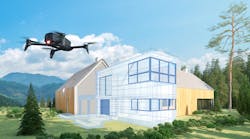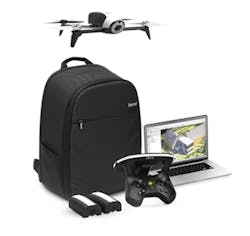AUVSI’s annual tradeshow, Xponential, highlights the latest in unmanned vehicle technology from robots to quadcopters to boats. It has changed over the years, starting with a focus on basic technology to this year where solutions are more the theme. New hardware is always showing up but now it is more about what can be done without being an expert or developer.
Parrot’s latest offerings highlight this change. The easiest to use is the Parrot Disco-AG. The efficient motor and high-capacity battery on the drone allows it to fly over 200 acres while recording information about what it flies over. The Disco drone comes with a handheld controller but typically a user will employ a tablet or smartphone to select a rectangular area on a map. The Flight Pro software then determines how to overfly the area. It is simply a matter of launching the drone and letting it run its course recording data that can be uploaded to the cloud for processing.
Parrot’s Disco-AG lets a user select an area to fly over. It is then a matter of launching the drone to fly its pattern and return with the results to be analyzed in the cloud.
The Disco can fly at speeds up to 50 miles/hr. for up to 45 minutes. A secure Wi-Fi link provides live streaming video that can also be useful, but it is the Sequoi sensor that makes this platform an agricultural tool. The system actually has four 1.2 Mpixel sensors that detect visible green and red plus two infrared sensors. A sunshine sensor allows radiometric calibration to be performed to provide more consistent data measurements.
The Sequoi sensor records green and red visible light as well as two infrared bands.
The use of the AIRINOV First + cloud mapping software is included with the package. It allows analysis of up to 370 acres/week and generates Normalized Difference Vegetation Index (NDVI) maps. These can reveal a crop’s health and water stress allowing adjustments to be made. The Sequoi sensor is available from AIRINOV directly.
The Disco-Pro AG is priced at $4,449. It includes a backpack, a Skycontroller 2, three 2700 mAh batteries, two extra propellers, and the drone with the Sequoia sensor. The Disco FPV (first-person view) is a version of the drone that comes with the Parrot Cockpitglasses for a virtual reality experience.
The next platform Parrot announced is the Bebop-Pro 3D. It is built around Parrot’s Bebop quadcopter (see “Bebopping Around”). This product targets architects, builder professionals, and realtors. It allows a Bebop to fly around a building using GPS to take pictures that include position information that is then used to render a 3D model of the exterior. The model can then be used to estimate upgrade work or design improvements.
The Bebop-Pro 3D flies around a structure grabbing enough photos to allow the analysis software to generate a 3D map of the structure.
The 3D analysis and rendering software is Pix4Dmodel from Pix4D. This is available separately and has been used on images captured by a range of drones. Pix4D’s software can generate full texture mesh models along with fly-through videos. Models can be enhanced in software for before and after presentations. Analysis and generation of models is done in the cloud.
The Bebop-Pro 3D is priced at $1,099. That includes a Bebop 2 with a backpack. It comes with a one year subscription for Pix4Dmodel. It also includes eight propellers so you have extras when one is destroyed. There are three batteries to allow for more flying time. The 2700 mAh battery delivers 25 minutes of flying time. The system uses the Bebop’s built-in, 14 Mpixel camera that is capable of recording 1080p HD video.
The Bebop-Pro 3D is priced at $1,099, which includes a Bebop 2 with a backpack.
The Parrot software can be used to identify the location of a structure with the software generating the automatic flight plan similar to what is done with the Disco-Pro AG. The difference is the center points of a building are usually selected along with a safe flying distance so the drone does not encounter the structure with its flight path.
The Bebop drone does not have any obstacle recognition or avoidance so it is a matter of making sure there is sufficient clearance. This is also true for the Disco-Pro AG, except that most fields tend to be clear of obstacles, with an occasional tree being an issue. The Bebop drone’s planning will often be more difficult because of adjacent buildings and other objects that tend to be more common around a building like poles and wires. Luckily a path can often be created that will avoid these obstacles.
A single structure may require more than one pass but on-board GPS allows the system to record where an image was taken and the orientation with respect to the building. Images from any number of passes can be combined providing more coverage and higher accuracy.
Bebop 2 Real Estate Edition is priced at $549 but the Pix4Dmodel license is for only one month. A perpetual license is $8,700 or an annual fee of $3,500. It is a lower-cost approach that allows users to try the service and is essentially the price of the drone alone. Users may find the service to be of use or they may simply like the drone to fly over while recording video.
The approach Parrot is taking is not unique and the services are being provided by third parties that cater to almost any platform. What Parrot does is greatly simplify the process for the user, allowing the drones to be used without requiring piloting while providing a valuable service. It may even be practical for someone to use their drone to provide these services to others.
Drone use is definitely changing and Parrot is on the cutting edge from a user’s point of view. Flying and using drones can be a fun hobby but these days it is more likely to be performing useful work.






